70,000 20,000–30,000 Unknown 30,000 End date September 70 AD | 20,000–30,000 10,000 30,000 10,000 | |
 | ||
Results Roman victory, Main rebel Judean forces subdued., Temple of Jerusalem destroyed. Combatants Jewish people, Judea, Roman Empire Similar First Jewish–Roman War, Bar Kokhba revolt, Siege of Masada, Jewish–Roman wars, Maccabean Revolt | ||
Siege of jerusalem ad 70
The Siege of Jerusalem in the year 70 was the decisive event of the First Jewish–Roman War. The Roman army, led by the future Emperor Titus, with Tiberius Julius Alexander as his second-in-command, besieged and conquered the city of Jerusalem, which had been occupied by its Jewish defenders in 66.
Contents
- Siege of jerusalem ad 70
- Siege
- Destruction of Jerusalem
- Roman
- Jewish
- Perceptions and historical legacy
- In later art
- References

The siege ended with the sacking of the city and the destruction of its Second Temple. The destruction of both the first and second temples is still mourned annually as the Jewish fast Tisha B'Av. The Arch of Titus, celebrating the Roman sack of Jerusalem and the Temple, still stands in Rome.
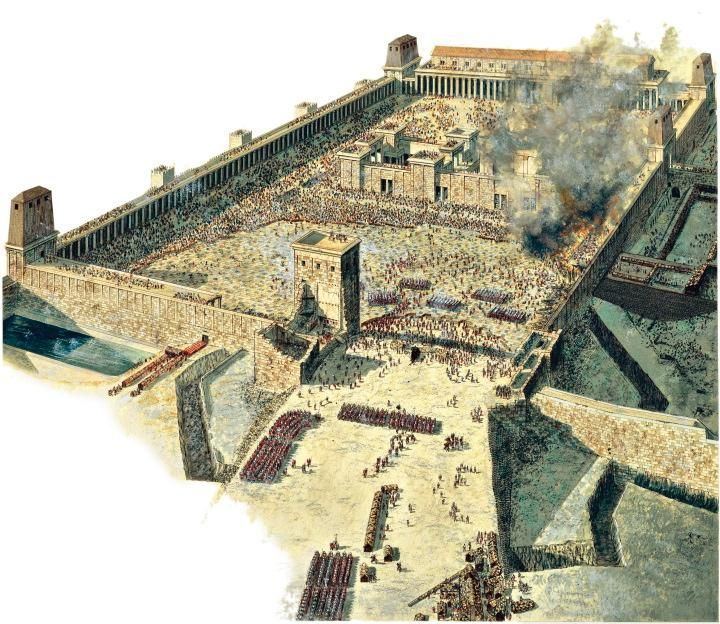
Siege

Despite early successes in repelling the Roman sieges, the Zealots fought amongst themselves, and they lacked proper leadership, resulting in poor discipline, training, and preparation for the battles that were to follow. At one point they destroyed the food stocks in the city, a drastic measure thought to have been undertaken perhaps in order to enlist a merciful God's intervention on behalf of the besieged Jews.
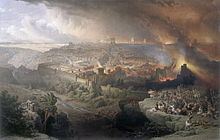
Titus began his siege a few days before Passover, surrounding the city, with three legions (V Macedonica, XII Fulminata, XV Apollinaris) on the western side and a fourth (X Fretensis) on the Mount of Olives to the east. If the reference in his Jewish War at 6:421 is to Titus' siege, though difficulties exist with its interpretation, then at the time, according to Josephus, Jerusalem was thronged with many people who had come to celebrate Passover. The thrust of the siege began in the west at the Third Wall, north of the Jaffa Gate. By May, this was breached and the Second Wall also was taken shortly afterwards, leaving the defenders in possession of the Temple and the upper and lower city. The Jewish defenders were split into factions: John of Gischala group murdered another faction leader, Eleazar ben Simon, whose men were entrenched in the forecourts of the Temple. The enmities between John of Gischala and Simon bar Giora were papered over only when the Roman siege engineers began to erect ramparts. Titus then had a wall built to girdle the city in order to starve out the population more effectively. After several failed attempts to breach or scale the walls of the Fortress of Antonia, the Romans finally launched a secret attack, overwhelming the sleeping Zealots and taking the fortress by late July.
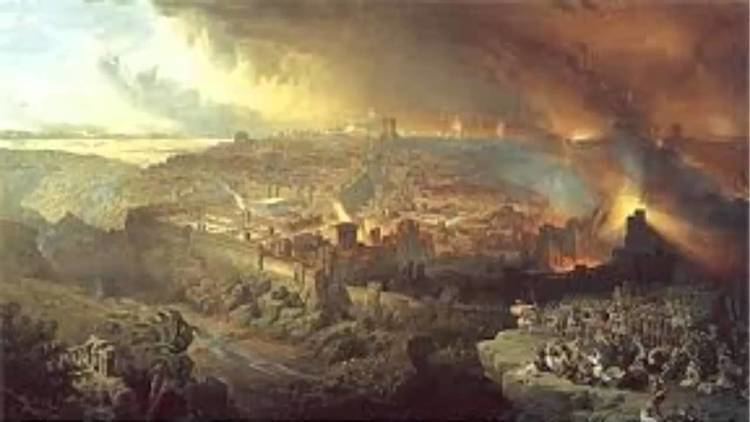
After Jewish allies killed a number of Roman soldiers, Titus sent Josephus, the Jewish historian, to negotiate with the defenders; this ended with Jews wounding the negotiator with an arrow, and another sally was launched shortly after. Titus was almost captured during this sudden attack, but escaped.
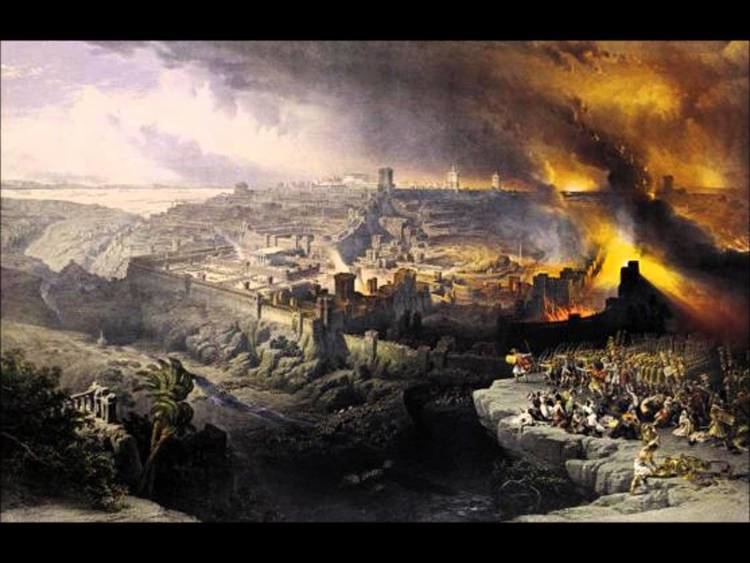
Overlooking the Temple compound, the fortress provided a perfect point from which to attack the Temple itself. Battering rams made little progress, but the fighting itself eventually set the walls on fire; a Roman soldier threw a burning stick onto one of the Temple's walls. Destroying the Temple was not among Titus' goals, possibly due in large part to the massive expansions done by Herod the Great mere decades earlier. Titus had wanted to seize it and transform it into a temple dedicated to the Roman Emperor and the Roman pantheon. The fire spread quickly and was soon out of control. The Temple was captured and destroyed on 9/10th of Tisha B'Av, at the end of August, and the flames spread into the residential sections of the city. Josephus described the scene:
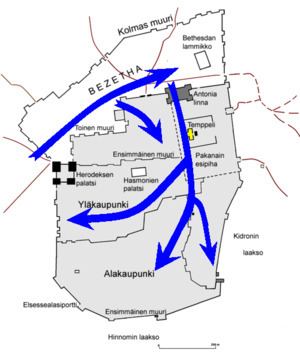
As the legions charged in, neither persuasion nor threat could check their impetuosity: passion alone was in command. Crowded together around the entrances many were trampled by their friends, many fell among the still hot and smoking ruins of the colonnades and died as miserably as the defeated. As they neared the Sanctuary they pretended not even to hear Caesar's commands and urged the men in front to throw in more firebrands. The partisans were no longer in a position to help; everywhere was slaughter and flight. Most of the victims were peaceful citizens, weak and unarmed, butchered wherever they were caught. Round the Altar the heaps of corpses grew higher and higher, while down the Sanctuary steps poured a river of blood and the bodies of those killed at the top slithered to the bottom.
Josephus's account absolves Titus of any culpability for the destruction of the Temple, but this may merely reflect his desire to curry favor with the Flavian dynasty.
The Roman legions quickly crushed the remaining Jewish resistance. Part of the remaining Jews escaped through hidden underground tunnels, while others made a final stand in the Upper City. This defence halted the Roman advance as they had to construct siege towers to assail the remaining Jews. The city was completely under Roman control by September 7, and the Romans continued to pursue those who had fled the city.
Destruction of Jerusalem
The account of Josephus described Titus as moderate in his approach and, after conferring with others, ordering that the 500-year-old Temple be spared. According to Josephus, it was the Jews who first used fire in the Northwest approach to the Temple to try and stop Roman advances. Only then did Roman soldiers set fire to an apartment adjacent to the Temple, a conflagration which the Jews subsequently made worse.
Josephus had acted as a mediator for the Romans and, when negotiations failed, witnessed the siege and aftermath. He wrote:
Now as soon as the army had no more people to slay or to plunder, because there remained none to be the objects of their fury (for they would not have spared any, had there remained any other work to be done), [Titus] Caesar gave orders that they should now demolish the entire city and Temple, but should leave as many of the towers standing as they were of the greatest eminence; that is, Phasaelus, and Hippicus, and Mariamne; and so much of the wall enclosed the city on the west side. This wall was spared, in order to afford a camp for such as were to lie in garrison [in the Upper City], as were the towers [the three forts] also spared, in order to demonstrate to posterity what kind of city it was, and how well fortified, which the Roman valor had subdued; but for all the rest of the wall [surrounding Jerusalem], it was so thoroughly laid even with the ground by those that dug it up to the foundation, that there was left nothing to make those that came thither believe it [Jerusalem] had ever been inhabited. This was the end which Jerusalem came to by the madness of those that were for innovations; a city otherwise of great magnificence, and of mighty fame among all mankind.
And truly, the very view itself was a melancholy thing; for those places which were adorned with trees and pleasant gardens, were now become desolate country every way, and its trees were all cut down. Nor could any foreigner that had formerly seen Judaea and the most beautiful suburbs of the city, and now saw it as a desert, but lament and mourn sadly at so great a change. For the war had laid all signs of beauty quite waste. Nor had anyone who had known the place before, had come on a sudden to it now, would he have known it again. But though he [a foreigner] were at the city itself, yet would he have inquired for it.
Josephus claims that 1.1 million people were killed during the siege, of which a majority were Jewish, and that 97,000 were captured and enslaved, including Simon bar Giora and John of Giscala. His figures are rejected as impossible by modern scholarship, since around the time about a million people lived in Palestine, probably about half of them were Jews, and sizable Jewish populations remained in the area after the war was over, even in the hard-hit region of Judea.
Many fled to areas around the Mediterranean. Titus reportedly refused to accept a wreath of victory, saying that the victory did not come through his own efforts but that he had merely served as an instrument of God's wrath.
Roman
Jewish
Perceptions and historical legacy
The Jewish Amoraim attributed the destruction of the Temple and Jerusalem as punishment from God for the "baseless hatred" that pervaded Jewish society at the time. Many Jews in despair are thought to have abandoned Judaism for some version of paganism, many others sided with the growing Christian sect within Judaism.
The destruction was an important point in the separation of Christianity from its Jewish roots: many Christians responded by distancing themselves from the rest of Judaism, as reflected in the Gospels which some believe portray Jesus as anti-Temple and view the destruction of the temple as punishment for rejection of Jesus.
In later art
The war in Judaea, particularly the siege and destruction of Jerusalem, have inspired writers and artists through the centuries. The bas-relief in the Arch of Titus has been influential in establishing the Menorah as the most dramatic symbol of the looting of the Second Temple.
